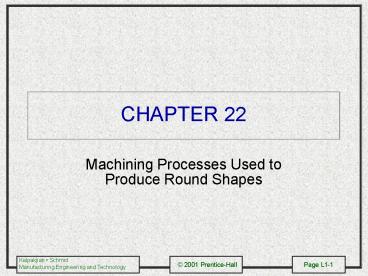Machining Processes Used to Produce Round Shapes - PowerPoint PPT Presentation
1 / 16
Title:
Machining Processes Used to Produce Round Shapes
Description:
Machining Processes Used to Produce Round Shapes. Kalpakjian Schmid ... Figure 22.1 Various cutting operations that can be performed on a late. ... – PowerPoint PPT presentation
Number of Views:176
Avg rating:3.0/5.0
Title: Machining Processes Used to Produce Round Shapes
1
CHAPTER 22
- Machining Processes Used to Produce Round Shapes
2
Cutting Operations
Figure 22.1 Various cutting operations that can
be performed on a late. Not that all parts have
circular symmetry.
3
Components of a Lathe
Figure 22.2 Components of a lathe. Source
Courtesy of Heidenreich Harbeck
4
General Characteristics of Machining Processes
5
Schematic Illustration of a Turning Operation
Figure 22.3 (a) Schematic illustration of a
turning operation showing depth of cut, d, and
feed, f. Cutting speed is the surface speed of
the workpiece at the Fc, is the cutting force, Ft
is the thrust or feed force (in the direction of
feed, Fr is the radial force that tends to push
the tool away from the workpiece being machined.
Compare this figure with Fig. 20.11 for a
two-dimensional cutting operation.
6
Right-Hand Cutting Tool
Figure 22.4 (a) Designations and symbols for a
right-hand cutting tool solid high-speed-steel
tools have a similar designation. Right-hand
means that the tool travels from right to left as
shown in Fig. 22.1a. (continued)
7
Right-Hand Cutting Tool (cont.)
Figure 22.4 (continued) (b) Square insert in a
right-hand toolholder for a turning operation. A
wide variety of toolholders are available for
holding inserts at various angles. Source
Kennametal Inc.
8
General Recommendations for Turning Tool Angles
9
Summary of Turning Parameters and Formulas
10
Cutting Speeds for Various Tool Materials
Figure 22.5 The range of applicable cutting
speeds and feeds for a variety of tool materials.
Source Valenite.
11
General Recommendations for Turning Operations
12
General Recommendations for Turning Operations
(cont.)
13
General Recommendations for Turning Operations
(cont.)
14
General Recommendations for Turning Operations
(cont.)
15
General Recommendations for Cutting Fluids for
Machining
16
Typical Capacities and Maximum Workpiece
Dimensions for Machine Tools































